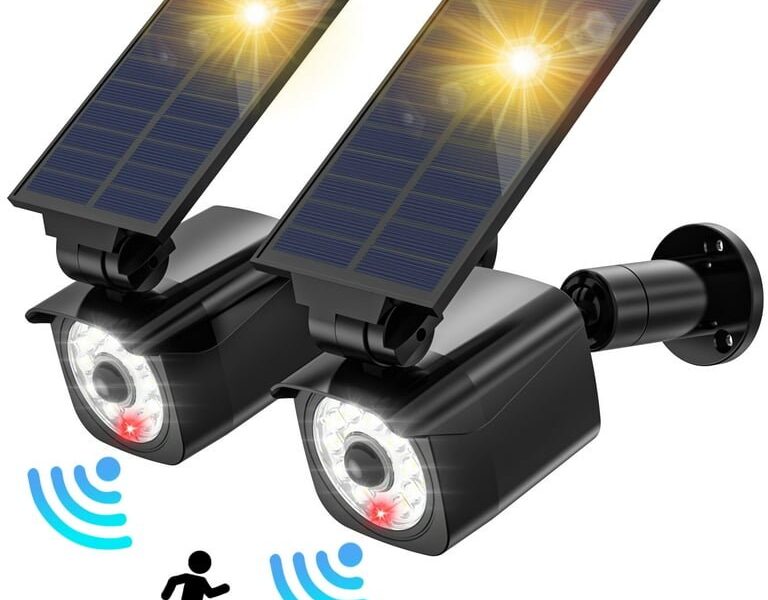Are you looking for a reliable way to enhance your home security? A solar security light with motion sensor offers the perfect solution. These lights not only illuminate your outdoor space but also deter intruders by activating with movement.
Imagine walking up to your home and feeling safer, knowing that the lights will turn on as soon as someone approaches. With their energy-efficient design, these lights keep your property well-lit while saving on electricity costs. Invest in peace of mind today with a solar security light that combines functionality with sustainability.
Solar Security Light with Motion Sensor: A Comprehensive Guide
When it comes to keeping your home safe, a solar security light with a motion sensor can be a fantastic investment. Not only does it enhance the security of your property, but it also uses renewable energy, which helps the environment and reduces your electricity bill. In this article, we’ll dive into everything you need to know about solar security lights with motion sensors, from how they work to the installation process, maintenance tips, and their benefits.
Understanding Solar Security Lights
Solar security lights are designed to illuminate areas around your home using solar energy. They capture sunlight during the day and convert it into electricity, which powers the light at night. Here’s how these lights typically work:
- Solar Panel: The solar panel collects sunlight during the day. It’s essential to install it in an area that receives direct sunlight for optimal performance.
- Batteries: The solar energy is stored in rechargeable batteries. These batteries power the light when it gets dark.
- LED Bulbs: Most solar security lights use LED bulbs because they are energy-efficient and long-lasting.
- Motion Sensor: The motion sensor detects movement in the area, triggering the light to turn on when someone approaches.
Why Choose Solar Security Lights?
Solar security lights with motion sensors offer several advantages. Here are some of the key benefits to consider:
Energy Efficient
Solar lights rely on renewable energy from the sun, so you don’t have to worry about high electricity bills.
Easy Installation
Because they don’t require wiring, solar security lights are easy to install. You can often do it yourself without needing an electrician.
Environmentally Friendly
Using solar energy reduces your carbon footprint, making these lights an eco-friendly choice.
Enhanced Security
The motion sensor feature makes these lights proactive rather than reactive. They alert potential intruders that the area is monitored, which can deter them from entering your property.
How Motion Sensors Work
Motion sensors are a crucial element of solar security lights. Understanding how they work can help you maximize their effectiveness. Here are the main types of motion sensors you might encounter:
PIR Sensors
Passive Infrared (PIR) sensors detect heat emitted by objects, distinguishing between moving people and stationary objects. They are widely used in security lights.
Microwave Sensors
These sensors emit microwaves and measure the reflection off moving objects. They are more sensitive than PIR sensors but can be affected by environmental factors.
Dual-Tech Sensors
Combining both PIR and microwave technologies, dual-tech sensors increase accuracy and minimize false alarms, making them a reliable choice for security lighting.
Choosing the Right Solar Security Light
When selecting a solar security light with a motion sensor, consider the following features:
Brightness
Look for lights with adjustable brightness levels. This can help you save battery life while ensuring you have adequate illumination when needed.
Detection Range
The detection range of the motion sensor is essential. Some lights can detect motion up to 30 feet away, while others may have a shorter range.
Weather Resistance
Since these lights are exposed to the elements, check for weatherproof ratings such as IP65. This ensures the light can withstand rain, snow, and harsh temperatures.
Battery Life
A good solar security light should have a battery that lasts through the night. Look for models with lithium-ion batteries as they typically provide longer life and better performance.
Installation Flexibility
Some lights come with a detachable solar panel. This feature allows you to place the panel in a sunny spot while positioning the light wherever you need it.
Installation of Solar Security Lights
Installing a solar security light with a motion sensor can be a straightforward process. Follow these steps for a successful installation:
Step 1: Choose the Right Location
Opt for a spot that receives ample sunlight during the day and covers the area you want to monitor. Common locations include driveways, entrances, and backyards.
Step 2: Assemble the Light
Follow the manufacturer’s instructions to assemble the light. This usually involves attaching the solar panel to the light fixture.
Step 3: Mount the Light
Use screws or anchors provided to mount the light on a sturdy surface. Ensure it is securely fastened and positioned to capture motion effectively.
Step 4: Adjust the Settings
Most models have adjustable settings for sensitivity, duration, and brightness. Take the time to customize these settings to suit your needs.
Step 5: Test the Light
After installation, test the motion sensor by walking in front of it to ensure it activates as expected.
Maintenance Tips for Solar Security Lights
To ensure your solar security light operates efficiently, follow these maintenance tips:
Regular Cleaning
Dirt and debris can accumulate on the solar panel, reducing its ability to charge. Clean the panel periodically with a soft cloth and water.
Check the Batteries
Over time, batteries may lose their capacity. Replace them as needed, following the manufacturer’s guidelines.
Inspect for Damage
Regularly check the light and motion sensor for any signs of damage or wear. Address any issues promptly to maintain functionality.
Adjust Sensor Settings
As the seasons change, you may need to adjust the motion sensor settings to account for different weather conditions and daylight hours.
Keep the Area Clear
Ensure that plants, shrubs, and other objects do not block the sensor’s view. This will keep the motion detection reliable and effective.
Comparing Solar Security Lights vs. Traditional Security Lights
When it comes to security lighting, you have a choice between solar-powered and traditional electrical lights. Here’s a side-by-side comparison:
Energy Usage
Solar Security Lights: Operate on solar power, reducing electricity costs.
Traditional Lights: Depend on electricity from the grid, increasing your utility bills.
Installation Effort
Solar Security Lights: Easy DIY installation without wiring.
Traditional Lights: Often require professional installation due to wiring and electrical work.
Environmental Impact
Solar Security Lights: Eco-friendly and reduce carbon footprints.
Traditional Lights: Contribute to higher energy consumption and environmental impact.
Performance in Outages
Solar Security Lights: Continue operating during power outages.
Traditional Lights: Stop working when the power goes out.
Customer Reviews and Ratings
Customer feedback is invaluable when choosing a solar security light. Here’s what to look for:
Highlighting Pros
Users love the ease of installation, effectiveness of motion sensors, and energy savings. Many appreciate not needing to change batteries frequently.
Identifying Cons
Some customers may report issues related to battery life or sensitivity settings. Look for patterns in reviews to identify potential problems.
Product Ratings
Choose lights with higher ratings and positive feedback. A rating of 4 stars or above generally indicates good performance.
Cost Considerations
The price of solar security lights can vary widely based on features and quality. Here’s a general breakdown:
Budget Models
Basic models can cost between $20 to $50. They usually have lower brightness and fewer features.
Mid-Range Models
These lights typically range from $50 to $100. They come with better battery life, brighter LEDs, and responsive motion sensors.
High-End Models
Premium options can exceed $100. They often feature advanced technology, such as dual sensors, customizable settings, and enhanced brightness.
Popular Brands and Models
Several brands have established themselves in the solar security light market. Here are some popular options:
LITOM
Known for its powerful brightness and wide-angle coverage, LITOM solar lights are highly rated by users for reliability and performance.
Ring
Ring offers solar security lights that easily integrate with their smart home systems, providing added features like app control and alerts.
URPOWER
URPOWER lights are praised for their affordability and effective motion sensing, making them a popular choice for budget-conscious consumers.
Moonrays
Moonrays offers a variety of decorative outdoor lights that combine aesthetics with functionality, perfect for enhancing curb appeal.
Installing Additional Security Features
While solar security lights with motion sensors provide excellent security, consider adding other features for enhanced protection:
Security Cameras
Pair solar lights with security cameras to monitor your property around the clock. Many modern cameras have night vision capabilities, making them effective even in low light.
Alarm Systems
Integrating an alarm system adds an extra layer of security. Motion detectors connected to alarms can alert you to any intrusion.
Smart Home Integration
Look for solar security lights that can connect with smart home devices. This integration allows for remote monitoring and control from your smartphone.
A solar security light with a motion sensor is not just a lighting solution; it’s an investment in the security and safety of your home. With
Proxinova™ Solar Security Light Outdoor Bright Wireless Dummy Camera Motion Sensor LED
Frequently Asked Questions
“`html
How do solar security lights with motion sensors work?
Solar security lights with motion sensors use solar panels to convert sunlight into electricity, which powers the light. During the day, the solar panel charges an internal battery. At night, the motion sensor detects movement and activates the light, providing illumination only when necessary. This energy-efficient design reduces energy costs while enhancing security.
What are the advantages of using solar security lights compared to traditional lights?
Solar security lights offer several benefits over traditional electric lights. They are energy-efficient since they rely on solar power, which can significantly lower electricity bills. These lights are also easy to install, often requiring no wiring, and they work well in remote areas where electrical access may be limited. Additionally, they are eco-friendly, contributing to a reduction in carbon footprints.
Can solar security lights function in cloudy or rainy weather?
Yes, solar security lights can function in cloudy or rainy weather, although their performance may slightly decrease. Most modern solar lights have efficient solar panels that can still gather some energy during overcast conditions. Additionally, they typically feature rechargeable batteries that store energy for use on days with less sunlight.
How far can the motion sensors detect movement?
The detection range of motion sensors in solar security lights varies by model, but most can detect movement within a range of 15 to 40 feet. Factors such as the angle of the sensor and environmental conditions can influence detection performance. Some models also allow users to adjust sensitivity settings for optimal performance.
What maintenance do solar security lights require?
Solar security lights require minimal maintenance. Regularly clean the solar panel to ensure it captures sunlight effectively and check for any obstructions around the motion sensor. Periodically inspect the battery, as it may need replacing every few years, depending on usage and model. Keeping the lights free from debris will help them function efficiently.
Are solar security lights effective at deterring intruders?
Yes, solar security lights are effective at deterring intruders. The sudden illumination triggered by motion sensors can startle potential intruders, making them more likely to avoid the area. Additionally, the presence of visible lights enhances security by increasing visibility around your property, thereby discouraging criminal activity.
“`
Final Thoughts
Solar security lights with motion sensors provide an effective solution for enhancing outdoor safety. They illuminate areas only when movement is detected, conserving energy while offering peace of mind.
Installing these lights around your property can deter unwanted visitors and improve visibility during the night. Their environmentally friendly design also ensures you save on electricity costs.
In summary, a solar security light with motion sensor combines efficiency and security for your home or business. By choosing this system, you invest in safety, sustainability, and convenience.





